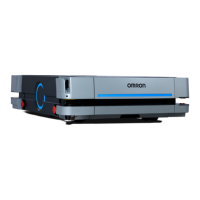33 HD-1500 Platform User's Manual 31500-000 Rev A
2.3 What to Do in an Emergency
In the event of an emergency stop:
l
The AMR uses motor power to come to a controlled stop then engages its motor brakes
and removes power to its drive motors.
l
Indicator lights on the AMR, and the pendant (if attached) show the E-Stop state. See:
Light Discs and Beacon on page 199 and Front and Back Light Strips on page 202.
A user-initiated E-Stop (category 1 stop) differs from a laser-initiated protective stop. The latter
occurs when one or both of the AMR's safety scanning laser detects an object within its pro-
tected zone. In such cases, the AMR safely stops, and then resumes operation after a delay of
at least two seconds, and after confirming that its protected zone is clear of obstacles. See: Pro-
tective Stops Initiated by AMR Safety Lasers on page 49.
The category 1 stop, which is activated by pressing one of the E-Stop buttons, is a controlled
stop function. In this case, the power to the AMR motors remains on in order to achieve a con-
trolled stop. Once the controlled stop is achieved, the power to the motors is disconnected. If
for any reason the controlled stop function fails or does not function as expected, the power
will still be disconnected to the motors. Category 1 stop function requires manual deactivation
of the E-Stop button, and manual reset of the AMR through the ON button for the AMR to
restart its operation. The AMR will not automatically recover from a category 1 stop, or any E-
Stop initiated by custom inputs on the User Safety Interface.
To use an E-Stop button:
1. Push firmly on the red button so that it latches.
2.
Follow your site-specific emergency and safety procedures.
If you need to move the AMR manually after correcting the emergency condition, press and
hold the brake release button and move the AMR. You can also use the pendant to drive the
AMR manually, if it is safe to do so. In order to use the pendant, you must first release the
E-Stop.
To enable the AMR's drive motors and put it back into service, follow the procedure described
in: Releasing an E-Stop on page 34.
Releasing the Brakes
In case of an emergency or abnormal situation, the AMR can be manually moved. However,
only qualified personnel who have read and understood this manual and the Mobile Robot
HDSafety Manual (Cat. No. I647) should manually move the platform. The brakes on the drive
wheels can be released with the brake release button. This requires battery power, and an E-
Stop must be pressed on the AMR.
NOTE: You should move the HD-1500 manually only when absolutely neces-
sary during an emergency, for safety, or if it is lost or stuck. If you find that you
must frequently move the HD-1500, use MobilePlanner to reconfigure its route to
avoid problem areas.
WARNING: PERSONALINJURYORPROPERTYDAMAGERISK
Using the brake release button while the HD-1500 is positioned on a slope of
greater than 3% will cause the HD-1500 to roll down. You must not use the
brake release button to move the HD-1500 manually, when positioned on a
slope of greater than 3%, unless necessary precautions have been taken to pre-

